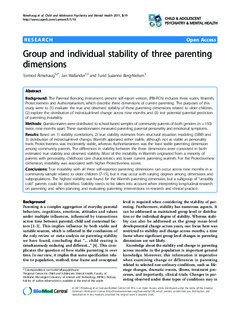Group and Individual Stability of Three Parenting Dimensions
Journal article, Peer reviewed
Permanent lenke
http://hdl.handle.net/11250/2356229Utgivelsesdato
2011Metadata
Vis full innførselOriginalversjon
Child and Adolescent Psychiatry and Mental Health 2011, 5(19) 10.1186/1753-2000-5-19Sammendrag
Background:
The Parental Bonding Instrument, present self-report version, (PBI-PCh) includes three scales, Warmth, Protectiveness and Authoritarianism, which describe three dimensions of current parenting. The purposes of this study were to (1) evaluate the true and observed stability of these parenting dimensions related to older children, (2) explore the distribution of individual-level change across nine months and (3) test potential parental predictors of parenting instability.
Methods:
Questionnaires were distributed to school-based samples of community parents of both genders (n = 150) twice, nine months apart. These questionnaires measured parenting, parental personality and emotional symptoms.
Results:
Based on 1) stability correlations, 2) true stability estimates from structural equation modeling (SEM) and 3) distribution of individual-level change, Warmth appeared rather stable, although not as stable as personality traits. Protectiveness was moderately stable, whereas Authoritarianism was the least stable parenting dimension among community parents. The differences in stability between the three dimensions were consistent in both estimated true stability and observed stability. Most of the instability in Warmth originated from a minority of parents with personality, childhood care characteristics and lower current parenting warmth. For the Protectiveness dimension, instability was associated with higher Protectiveness scores.
Conclusions:
True instability with all three self-reported parenting dimensions can occur across nine months in a community sample related to older children (7-15), but it may occur with varying degrees among dimensions and subpopulations. The highest stability was found for the Warmth parenting dimension, but a subgroup of "unstably cold" parents could be identified. Stability needs to be taken into account when interpreting longitudinal research on parenting and when planning and evaluating parenting interventions in research and clinical practice.
